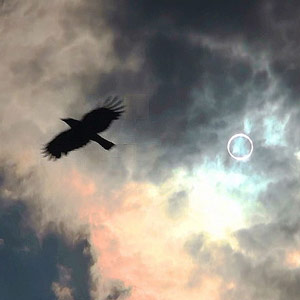Pratique | Débuter
Les effets des éclipses solaires sur le comportement de certains oiseaux

Corneille en vol à Kofu (Japon) lors de l’éclipse solaire du 21 mai 2012.
Photographie : Sakaori / Wikimedia Commons
Introduction
Une éclipse solaire (ou plus exactement une occultation solaire) se produit lorsque la Lune se place devant le Soleil, occultant totalement ou partiellement l’astre lumineux vu depuis la Terre. Un tel phénomène a lieu ce 21 août 2017 dans une partie des États-Unis : l’éclipse sera totale le long d’une bande étroite le long d’un couloir de 113 km de large allant de l’Oregon à la Caroline du Sud. De nombreux animaux (poissons, mammifères, oiseaux) changent leur comportement juste avant ou durant la période au cours de laquelle le soleil est totalement ou en grande partie caché. Dans cet article, nous vous présentons plusieurs exemples de perturbations observées chez les oiseaux.
Abstract
A solar eclipse (or a solar occultation) occurs when the Moon moves in front of the Sun, totally or partially obscuring the bright star from Earth. Such a phenomenon will take place in the United States the 21th of August 2017: it will be total along a narrow band from Oregon to South Carolina. Many animals (fish, mammals, birds) change their behavior just before or during the period during which the sun is completely or largely hidden. In this article, we present several examples of disturbances noticed in birds.
Poursuivez la lecture de cet article, en vous abonnant dès maintenant !
Découvrez les Archives d’Ornithomedia.com
Pour seulement 10,00 €TTC/an (ou 6,00 € les 6 mois)
Profitez de plusieurs centaines d’articles en accès illimité et sans aucun engagement.
Compléments
À lire aussi sur Ornithomedia.com
- Anatomie des Oiseaux
- La vision des oiseaux
- Pourquoi certains oiseaux crient-ils et/ou chantent-ils la nuit ?
- Comment voient les oiseaux et comment limiter les collisions ?
- L’organe paratympanique, le baromètre interne des oiseaux
- Le chœur de l’aube des oiseaux, plus qu’un simple concert matinal
Ouvrages recommandés
- Anatomie Des Oiseaux Frederic P. Miller, Agnes F. Vandome et John McBrewster
- Bird Anatomy II: The Surface Anatomy of Birds Noble S. Proctor et Patrick Lynch
- The Inner Bird: Anatomy and Evolution Gary W. Kaiser
- Le comportement animal : Psychobiologie, éthologie et évolution David McFarland, René Zayan et Jacqueline d’Huart
Sources
- Santhosh S Kumar (2014). Why Birds/Animals Fly/Run Away to Solar Eclipse? Current Advances in Environmental Science. février. www.vkingpub.com/VkUpload/201406191012315023.pdf
- Shin-Ichi (2010). Unusual avian vocal behavior during the total solar eclipse in the Tokara Islands, southern Japan. Bird Research (6). www.jstage.jst.go.jp/article/birdresearch/6/0/6_0_A1/_article
- Eclipsewatch (2015). Findings. www.eclipsewatch.in/?page_id=193
- Todd Thompson (2014). Observing Wildlife Reactions during a Total Solar Eclipse. Eclipse-chasers. www.eclipse-chasers.com/article/papers/wildlife01.html
- Elliot J. Tramer (2010). Bird Behavior During a Total Solar Eclipse. The Wilson Bulletin 112(3). Pages : 431-432. www.bioone.org
- Yu Changhao, Zou Qin, Zong Daosheng, Wan Yuanyuan, Deng Shuisheng et Kong Fanqian (2009). Influence of Total Solar Eclipse on Birds’Hehavior. Jiangxi Forestry Science and Technology. http://en.cnki.com.cn/Article_en/CJFDTOTAL-JXLI200906017.htm
- Hisamitsu A. et al (2009). « Response of animals and plants to the solar eclipse on 22 July 2009: Observation on the Nara [Japan] Campus of Kinki University. http://agris.fao.org/agris-search/search.do?recordID=JP2010003940
- Orhan Özbey, M. Hanifi Aysöndu, Hatice Özer, Ü. Gülcihan Şimsek (2004). The Effects of a Solar Eclipse on Animals Behavior. Turkish Journal of Veterinary and Animal Sciences (28). Pages : 55-61.http://mistug.tubitak.gov.tr/bdyim/abs.php?dergi=vet&rak=0205-44
- K. Elgmork (1962). Behaviour of Pied Flycatchers during an eclipse of the sun. British Birds. Volume 55, numéro 9. Septembre. http://britishbirds.co.uk/wp-content/uploads/article_files/V55/V55_N09/V55_N09_P385_387_A046.pdf
- Helle Halkjær Kristen. The effects of light intensity, gradual changes between light and dark and definition of darkness for the behaviour and welfare of broiler chickens, laying hens, pullets and turkeys. Norwegian Scientific Committee for Food Safety. www.vkm.no/dav/7643446bd0.pdf




Aucun commentaire sur ce sujet
Participer à la discussion !